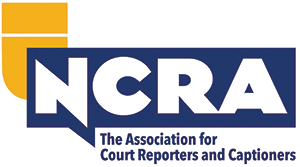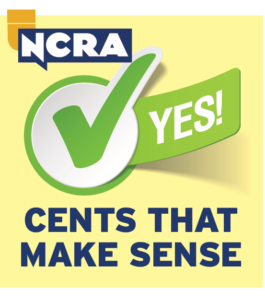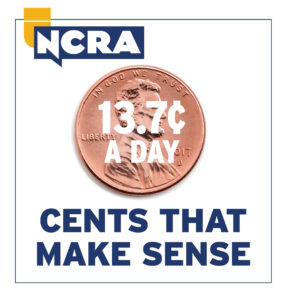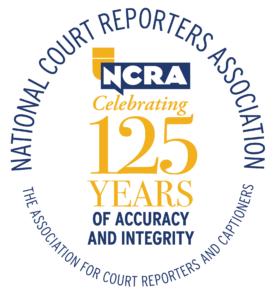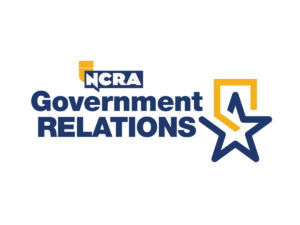During the NCRA Annual Business Meeting held prior to the 2021 NCRA Conference & Expo in Las Vegas, Nev., NCRA Executive Director Dave Wenhold, CAE, PLC, announced a new Strategic Plan. The Strategic Plan is the result of months of research and discussion by NCRA Stakeholder Groups, representing six segments of the membership, and the NCRA Board of Directors, and it presents a vision for the Association to follow for the next three years.
2021-2024 Strategic Plan
The 2021-2024 Strategic Plan shares the strategic goals and objectives for the National Court Reporters Association. The Strategic Plan is based on polls and surveys of the NCRA membership and, especially, the review and discussion of those results by six Stakeholder Groups representing different aspects of the membership: Freelancer, Official, Captioner, Firm Owner, Certified Legal Video Specialist, and Schools. The groups also reviewed previous strategic plans, previous member needs assessments, information gathered from members in their industry segments over the past two years, and feedback from the NCRA Board of Directors and staff.
Armed with that information, the groups discussed what they would like NCRA to tackle during the next few years. From those goals, the groups were asked to prioritize them and determine tactics to meet those goals. The result is the following group goals, which are to be assigned, as appropriate, to various committees as well as the NCRA Board of Directors and staff members.
The NCRA Board reviewed all of the goals from the Stakeholder Groups. Having the luxury of seeing everything from the 30,000-foot level, the Board evaluated whether the submitted priorities would fit into the overall work plan of NCRA.
The NCRA Board, its Executive Director, and its staff are grateful to all the volunteers who donated their valuable time to make this plan come together. Many priorities and tactics did not make this final cut, but that is no reflection of the worthiness of those priorities. It is simply a fact that NCRA does not have the bandwidth to do all the priorities for all the Strategic Groups identified. That being said, those ideas have been captured in the “wish lists,” and if NCRA has the ability and time to go back and tackle some of those issues after focusing on the top priorities, it has the next tier of items that will positively affect the individual Stakeholder Groups.
Another important point is that NCRA could not add new priorities and programs to the current workload if we did not have a mechanism in place to determine what is valuable and what can and should be replaced.
The 2021-2024 Strategic Plan is meant to be a living and dynamic document that serves as a guide for the organization and volunteer leaders. While the long-term mission and vision of the organization remains the same, the Strategic Plan establishes tangible deliverables in the short term (1 to 3 years). Throughout the short term, NCRA will continue to “keep its finger on the pulse” of the profession, member needs, and the industry at large to ensure that the Strategic Plan priorities remain relevant.
Building on a strong foundation
With an eye to the future, NCRA decided to create a new Strategic Plan to carry the Association – and its members – through the next three years. With the rapid restructure of the legal arena and many other areas of public life, NCRA sought direct input from members through JCR Weekly poll questions and an in-depth survey of members. In addition, six Stakeholder Groups – made of freelancers, officials, captioners, legal videographers, court reporting and captioning firm owners, and school administrators and court reporting instructors – were invited to engage in frank and open conversations about the future of the profession.
Taken together, this deep exploration of the current state of the industry allowed the NCRA Board of Directors and the Stakeholder Groups to gain the insights to create a guide for the next few years for the Association and the profession. The result is a new Strategic Plan, some of which is detailed here, for the NCRA Board, Committees, and staff to use as a blueprint for the next three years.
Overview
The goal of the 2021-2024 Strategic Plan is to establish a solid plan of action for the Association that supports members and aids in their professional growth in the fields of court reporting, captioning, and legal videography, as well as those who significantly support these professions, such as school administrators, teachers, and firm owners. Of significant note, this is the first time in more than a decade that the financial solvency of the Association has not been an issue simply because the Board and staff have reversed the trend of losing significant money each year. The organization is in a budget neutral position allowing this Strategic Plan to focus on programmatic issues.
In addition, conversations held by the Stakeholder Groups noted a number of programs that members already rely on or, of the newer ones, have come to appreciate and hope to see expanded. In sum, the group noted that NCRA has a solid foundation.
Following the discussions, the Stakeholder Groups were asked to use what they learned to develop goals for the Association to best serve the members over the next three years and from those goals pick their top priorities. The Board of Directors then reviewed the priorities to create a cohesive Strategic Plan. The following are a number of the goals that the Association will tackle in the next three years.
FREELANCER
- Increase public outreach to highlight the profession
- Review online testing platform, augment mentorship program, and create solutions for educational institutions wanting to add a stenography curriculum
- Support technology awareness and education
OFFICIAL
- Create tools to address the reporter shortage for all segments of the industry
- Create repository of best practices for officials
- Analyze record-keeping methods and create general best practices for decision makers
CAPTIONER
- Advocate for increased caption quality legislation and standardization for captioning on television and videos
- Revitalize strategic partners program
- Define and promote internally and externally the role of the professional captioner
FIRM OWNER
- Promote stenography over digital recording/automated speech recognition
- Create tools to address the reporter shortage for all segments of the industry
- Retool and relaunch NCRA Business Summit
CLVS
- Educate attorneys, paralegals, and judges about the importance of using a CLVS
- Revamp and revitalize the Trial Presentation Professional program
- Research hands-on testing regionally and/or at NCRA or state conferences
SCHOOLS
- Enhance the NCRA A to Z® Intro to Steno Machine Shorthand program by:
- Encouraging schools to tell enrollees they are strongly encouraged to take an NCRA A to Z program or similar before beginning the program
- Expanding NCRA A to Z programs into high schools to boost awareness of court reporting and to increase enrollment in court reporting programs
- Develop specific marketing tools for court reporting schools to use for recruitment
Areas of responsibility for implementation
Due to the large number of priorities proposed by the Stakeholder Groups, the most efficient way to handle them is to assign them in specific programmatic “buckets” of responsibility that seem to most closely align with the goals above. Further refining of the goals is expected, with possible input from established Committees. The priorities will be spread over the next three years in a way to build upon successes.
Public relations/marketing
- Create tools to address the reporter shortage for all segments of the industry (Official and Firm Owner)
- Promote stenography over digital recording/automated speech recognition (Firm Owner)
- Define and promote internally and externally the role of the professional captioner (Captioner)
- Educate attorneys, paralegals, and judges about the importance of using a CLVS (CLVS)
- Increase public outreach to highlight the profession (Freelancer)
- Develop specific marketing tools for court reporting schools to use for recruitment (School)
Education/professional development
- Support technology awareness and education (Freelancer)
- Create repository of best practices for officials (Official)
- Analyze record-keeping methods and create general best practices for decision-makers (Official)
- Revamp and revitalize the Trial Presentation Professional program (CLVS)
- Research hands-on testing regionally and/or at NCRA or state conferences (CLVS)
- Retool and relaunch NCRA Business Summit (Firm Owner)
- Review online testing platform, augment mentorship program, and create solutions for educational institutions wanting to add a stenography curriculum (Freelancer)
Advocacy
- Advocate for increased caption quality legislation and standardization for captioning on television and videos (Captioner)
- Work with state affiliates on the care, custody, and control of the record (regardless of methodology)*
Targeted programmatic initiatives
- Enhance NCRA A to Z program (Schools)
- Revitalize strategic partners program (Captioner)
- Integrate a diversity, equality, and inclusion directive**
*This strategic goal was added after a survey of all Stakeholder Group Reports. While this goal was not one that was chosen as a priority, similar language came up in all of the reports.
**This strategic goal was added by the Board of Directors.
What’s next?
While it’s great to have goals – and, as mentioned at the very beginning, a plan is only as good as the commitment of the individuals and Committees to fulfilling those goals – the next step is to take action. As mentioned, each of the goals has now been assigned to a programmatic bucket, and these will be the four areas of focus for NCRA to direct its attention to over the next three years.
- Focus on public relations and marketing
- Education and professional development initiatives
- Increased advocacy
- Targeted programmatic initiatives
In addition to determining the strategic priorities, each Stakeholder Group was asked to evaluate each goal for its importance, timing, and cost and to come up with the tactics that the Board, Committees, and staff should consider in turning these goals into reality. As an example, when a goal is given to a Committee to accomplish, the information should include a prioritization level, dates for when certain tactics are hoped to be completed, plans for follow-up or reporting progress, and so on. The Board has begun sharing the goals and tactics with the appropriate Committees, staff, or other individuals.
Are you wondering: “How can I help?”
Stay in the loop! One of the ideas that popped up across several different Stakeholder Groups was the need to provide more materials to support NCRA STRONG; reminding judges, lawyers, and captioning consumers why stenographers are often the best choice, as well as how legal videographers support steno reporters in the legal field; and finding ways to recruit more people into the field through greater use of the NCRA A to Z® Intro to Steno Machine Shorthand program. As these initiatives come to fruition, they will be shared with members, firms, and schools to use – and you will be helping yourself and everyone else by using them as you deem appropriate.
If you want to get more involved, please volunteer! If you want to be a part of an NCRA Committee, all you need to do is let us know. Committees begin their work immediately following the NCRA Conference & Expo. Even though the Committees are finalized before the Conference, you can volunteer at any time, as we may have openings throughout the year. If we don’t have an opening, we will keep your name on file for the following year – and as our Strategic Plan covers the next three years, there will be time to be a part of something that matters to you. If you want to participate in one of the Committees, contact Laura Butler at lbutler@ncra.org.
For more information about the 2021-2024 Strategic Plan, please see the September issue of the JCR.
